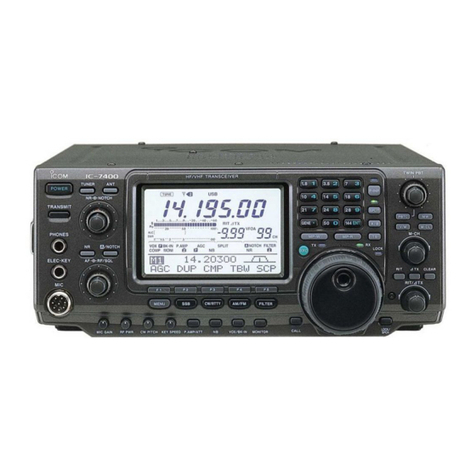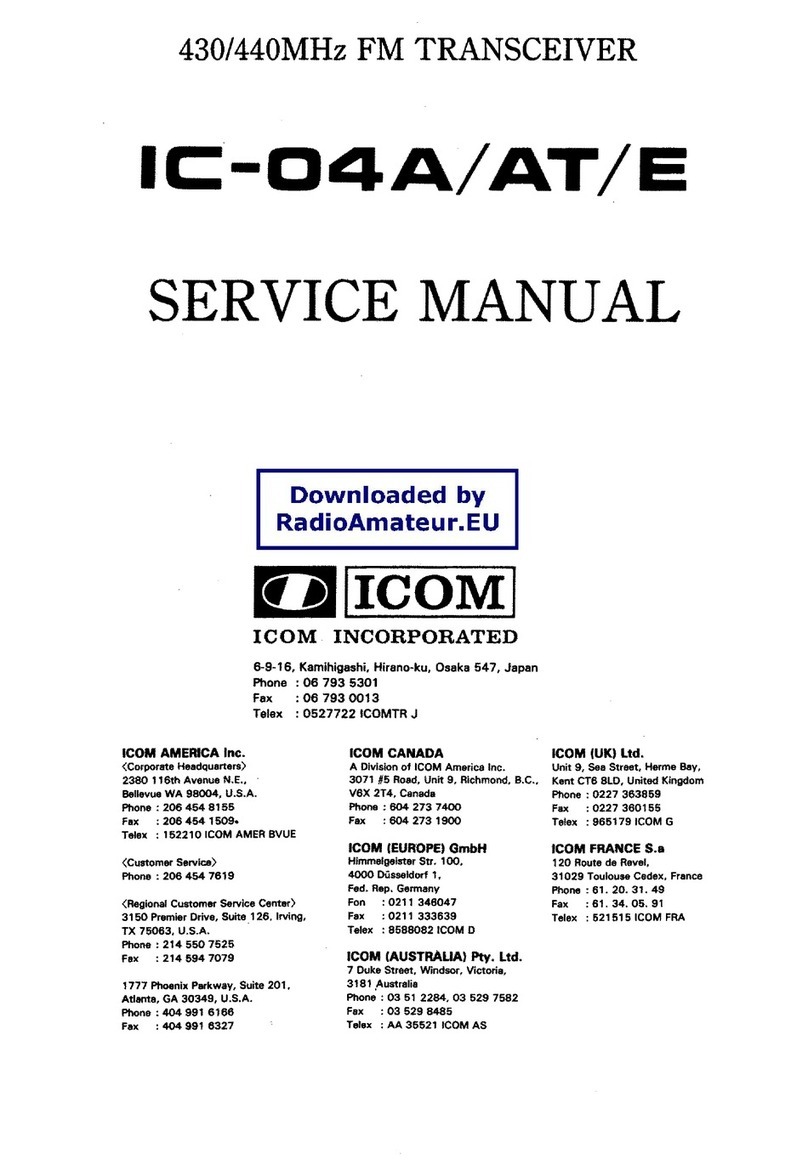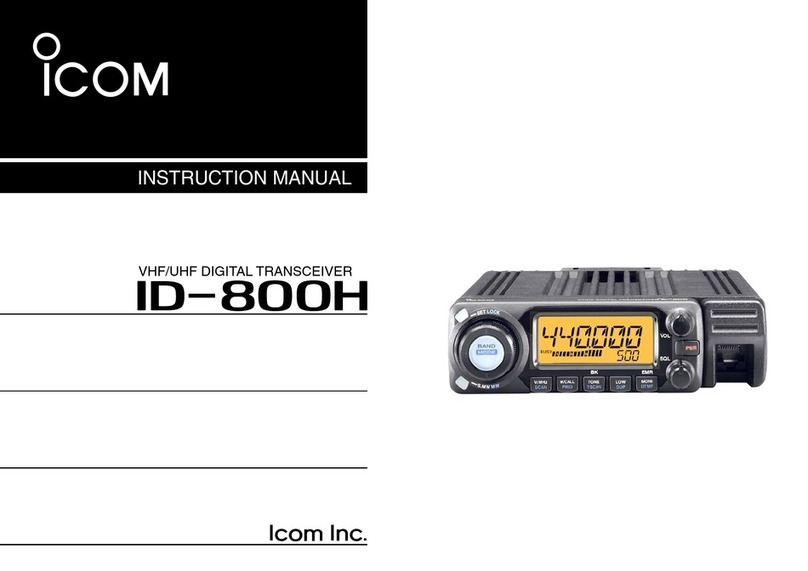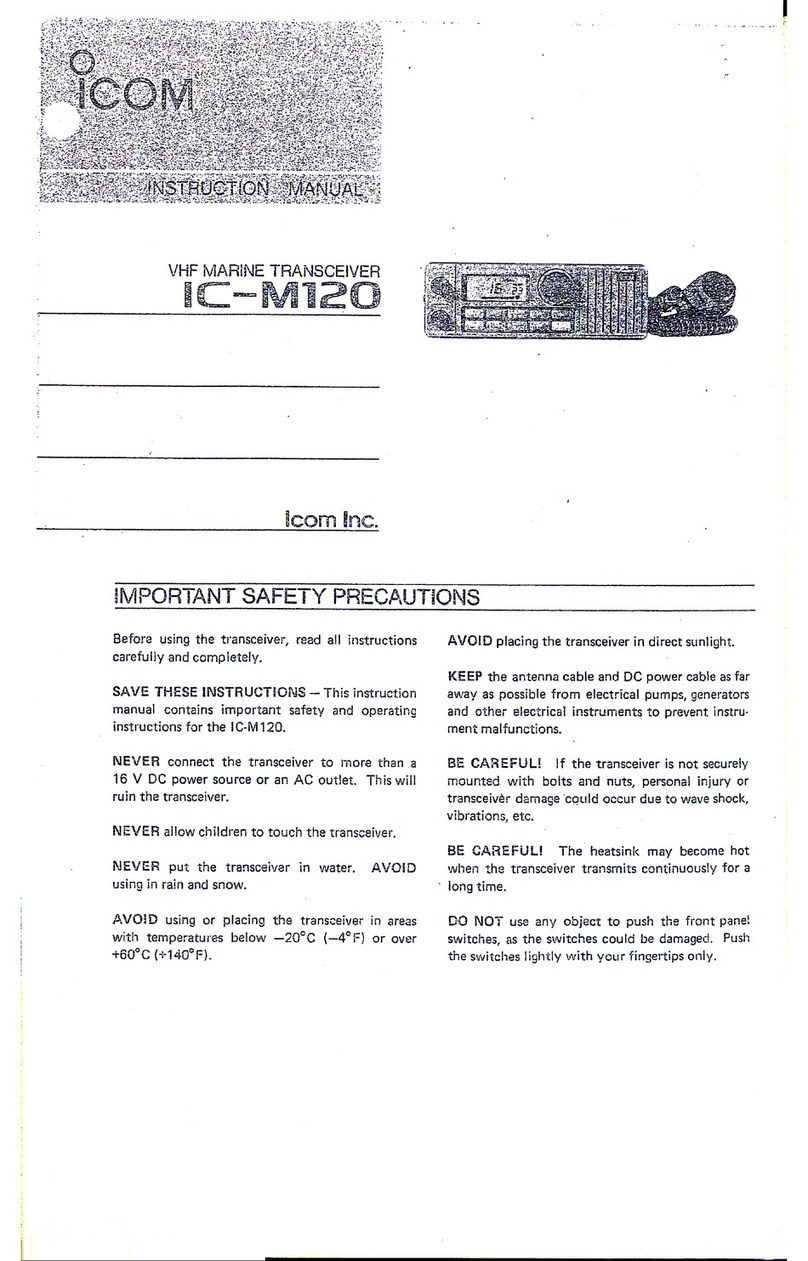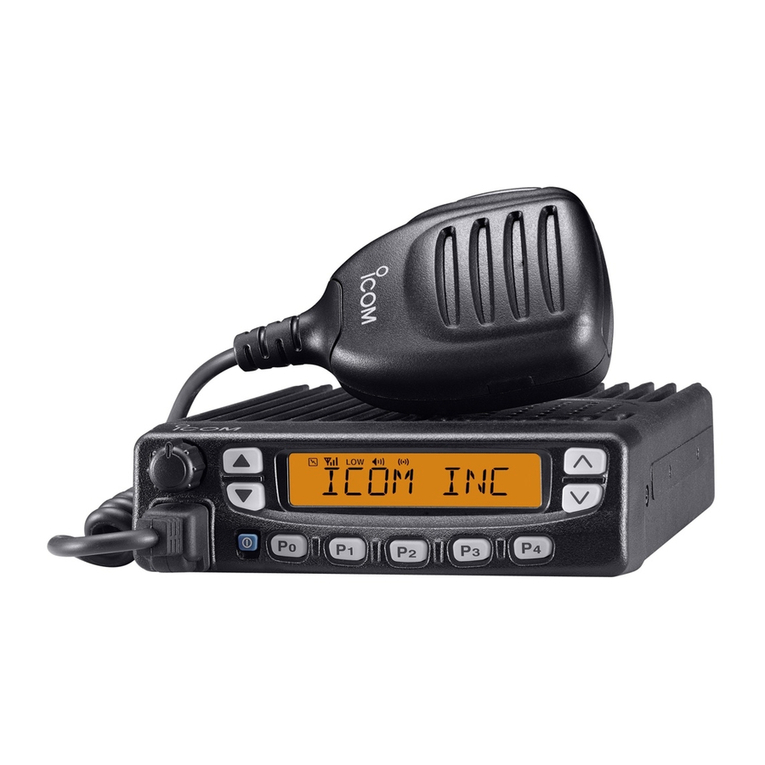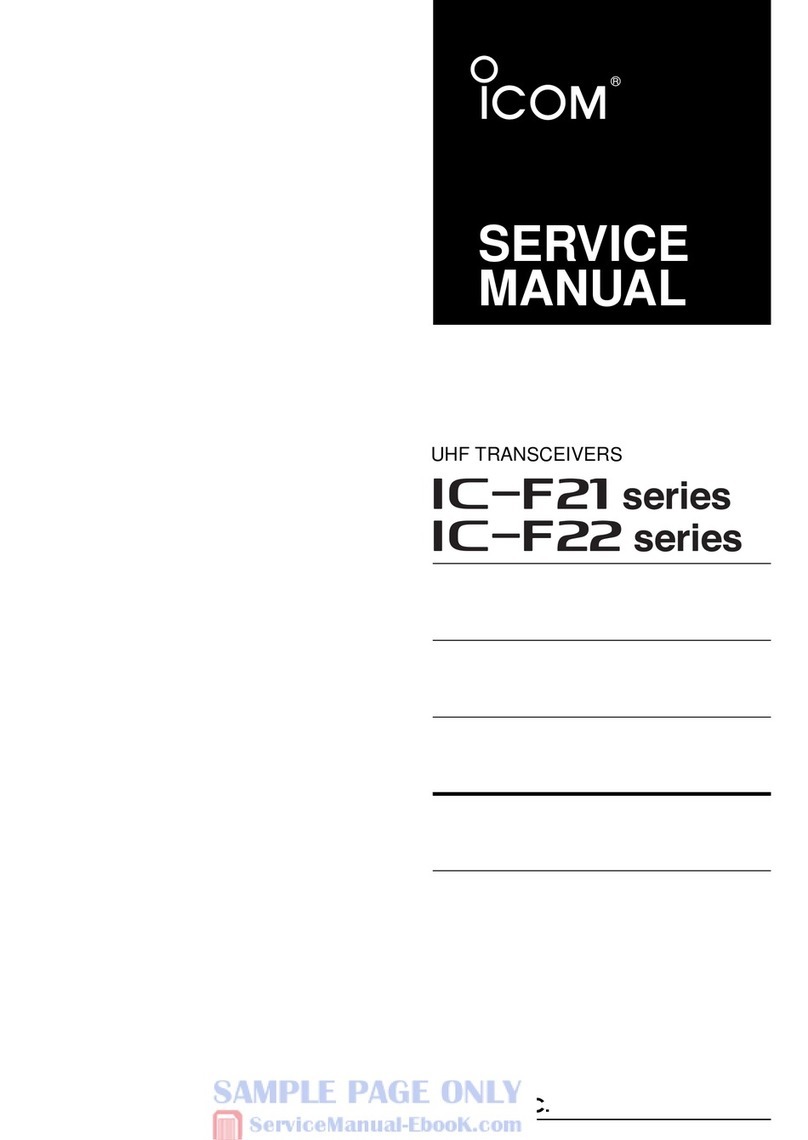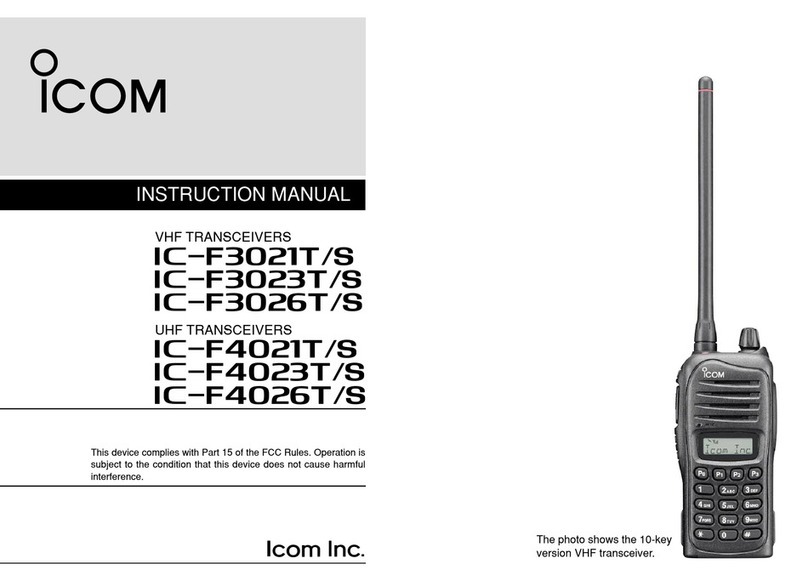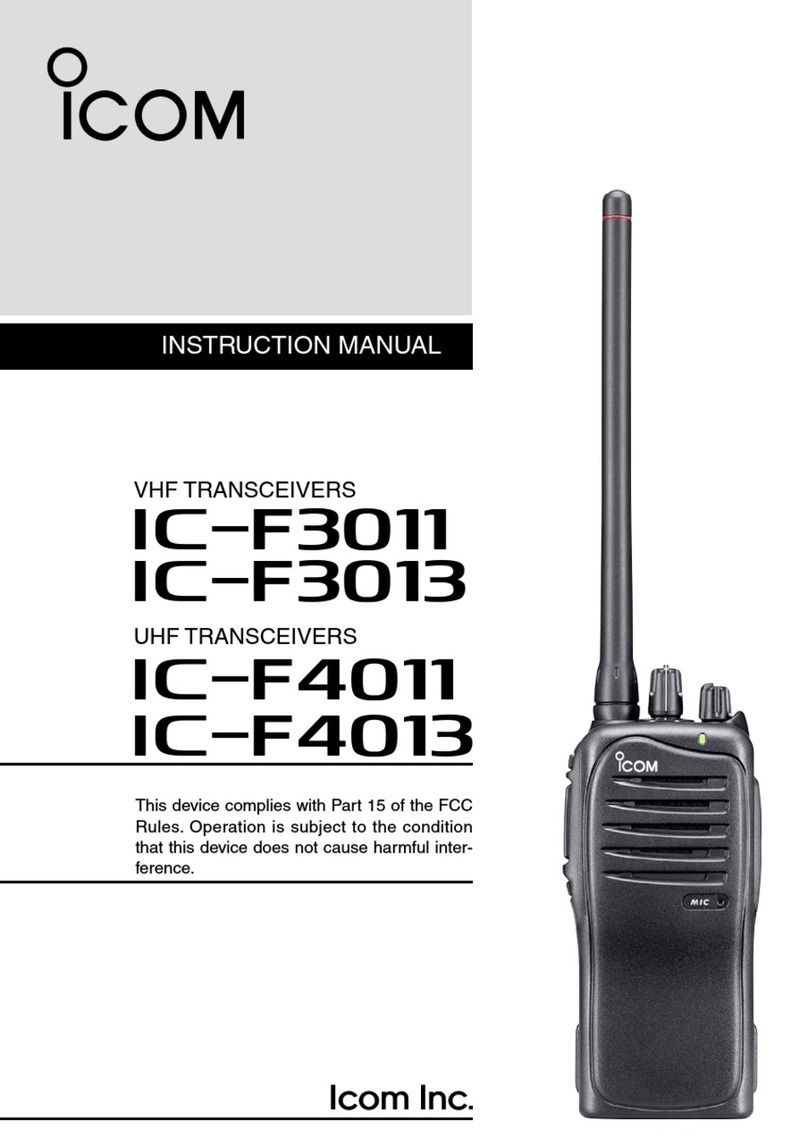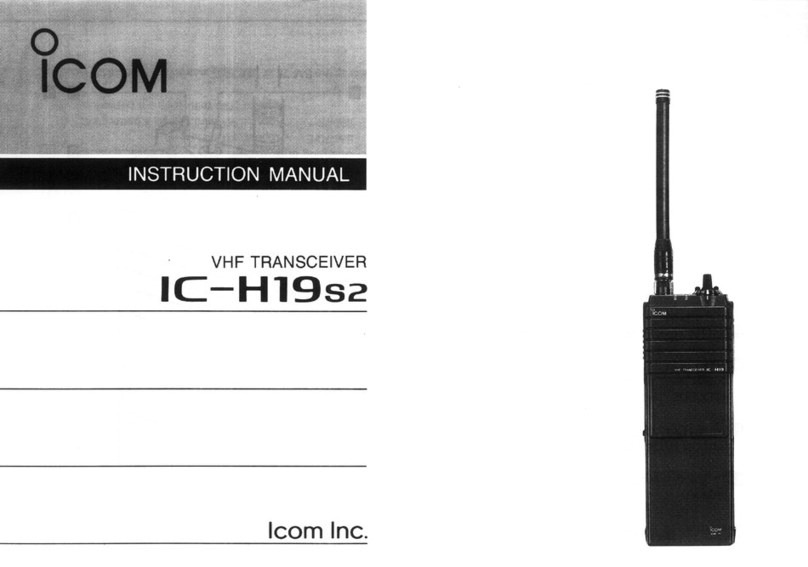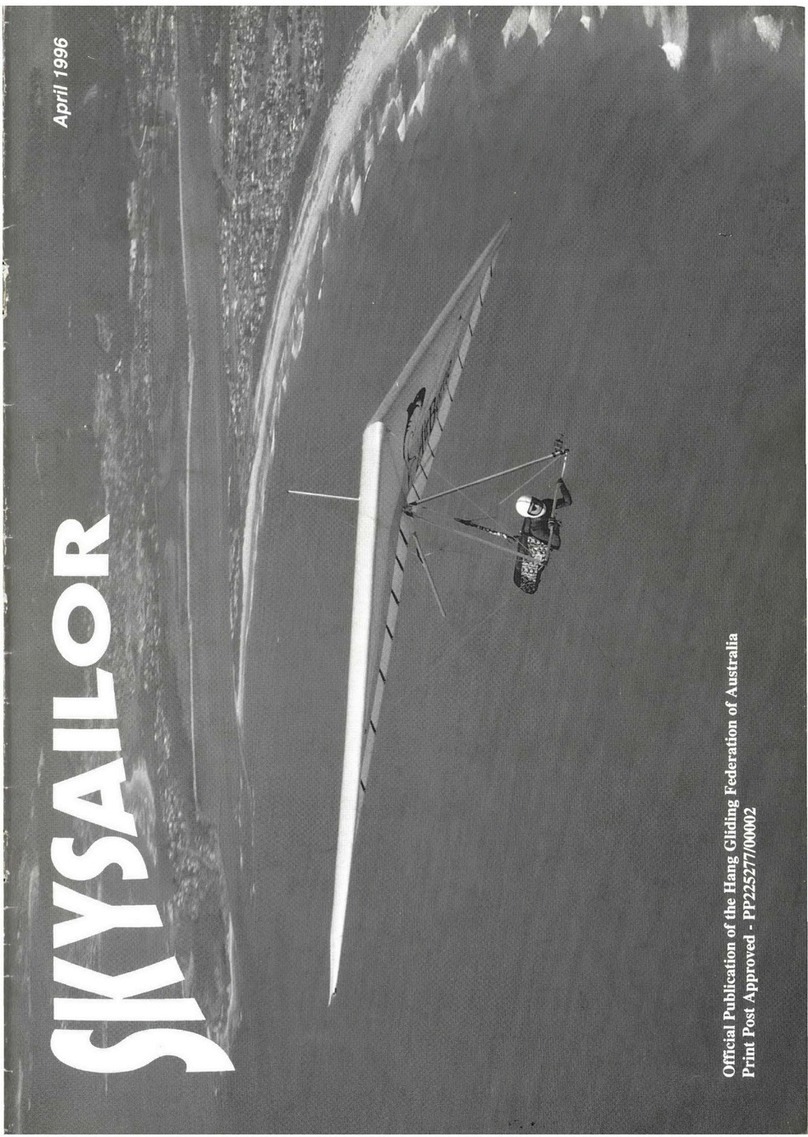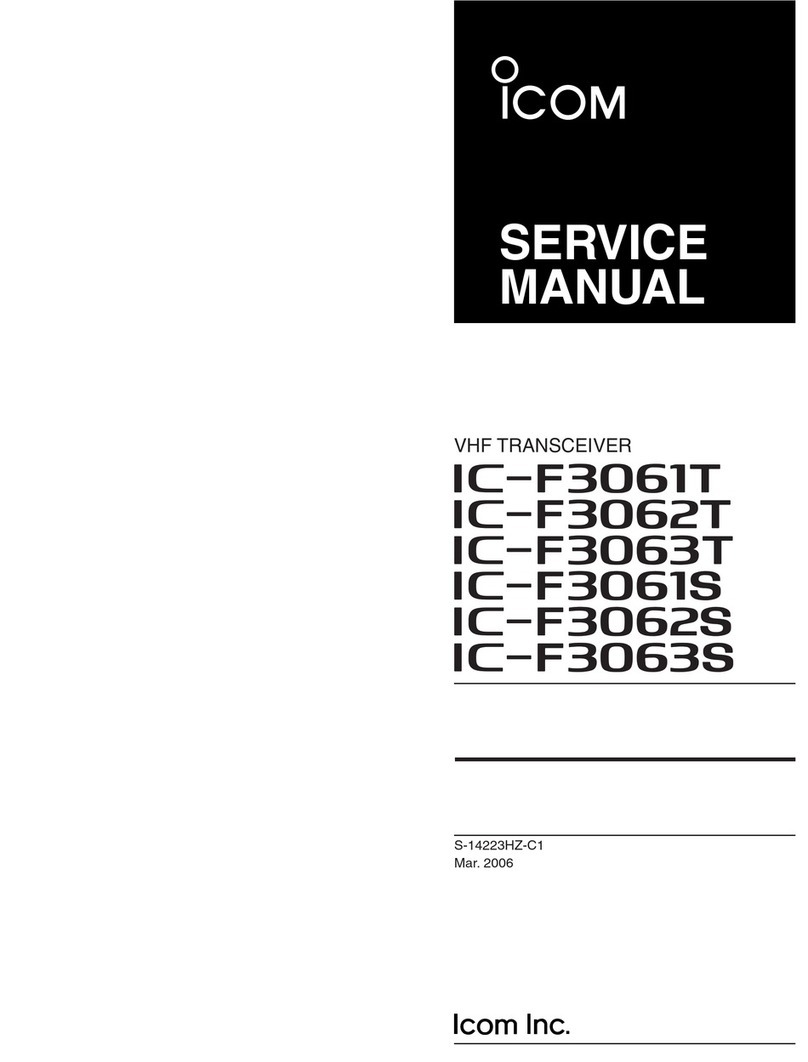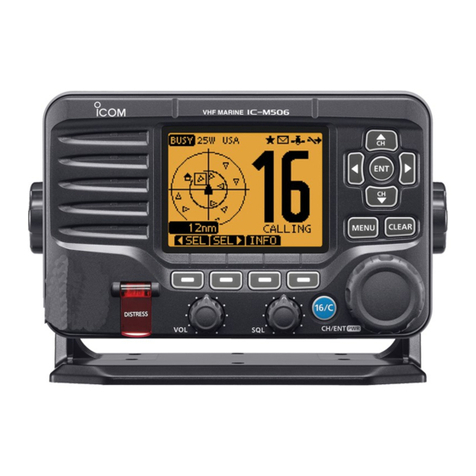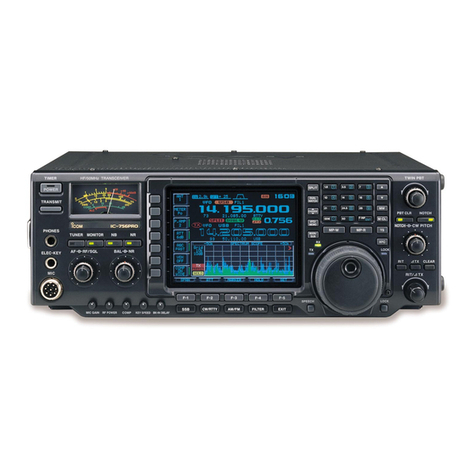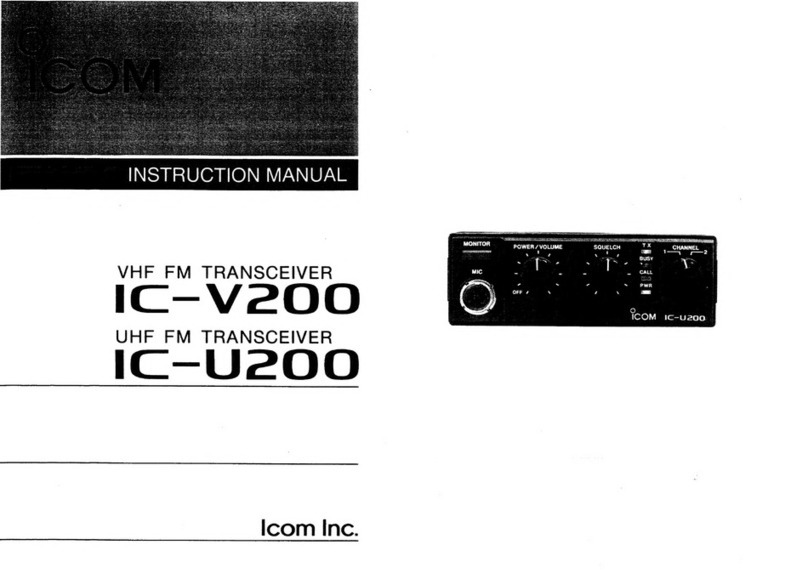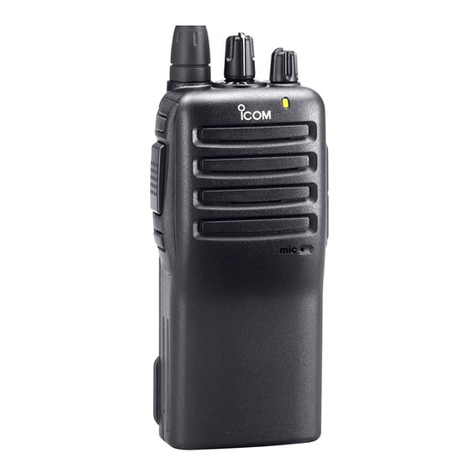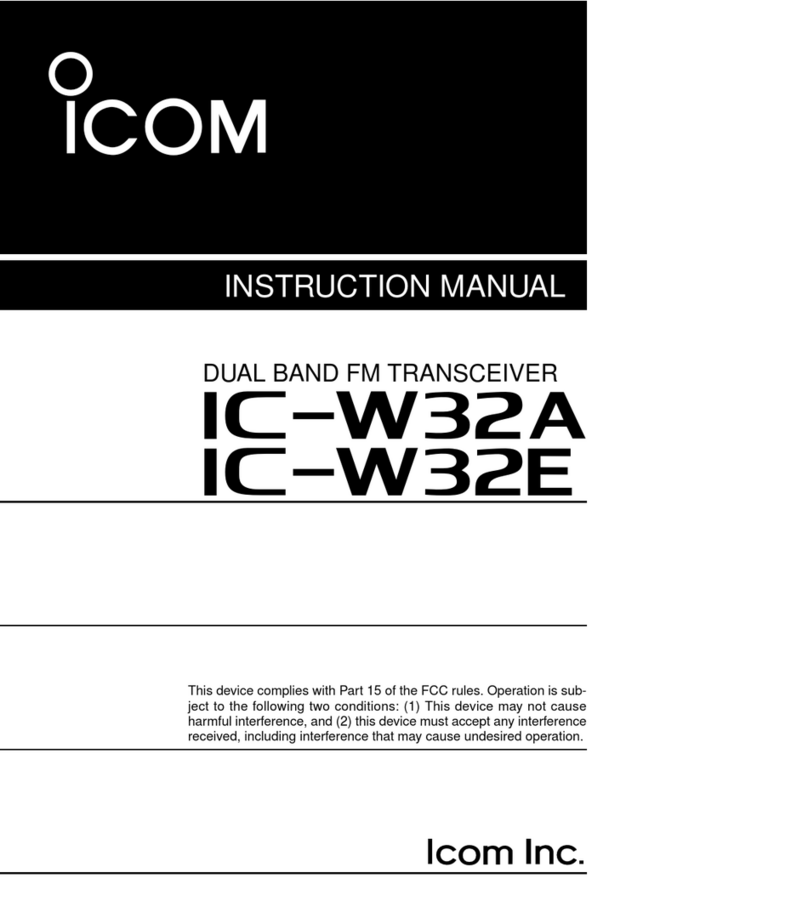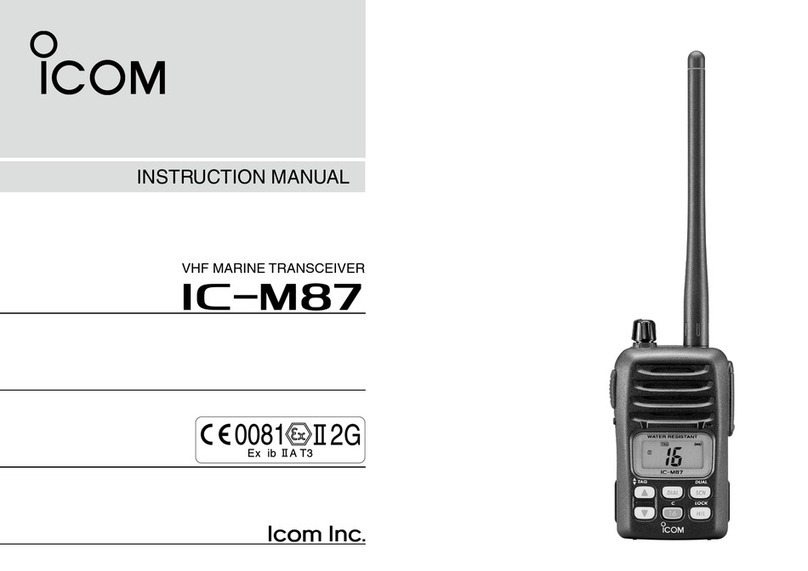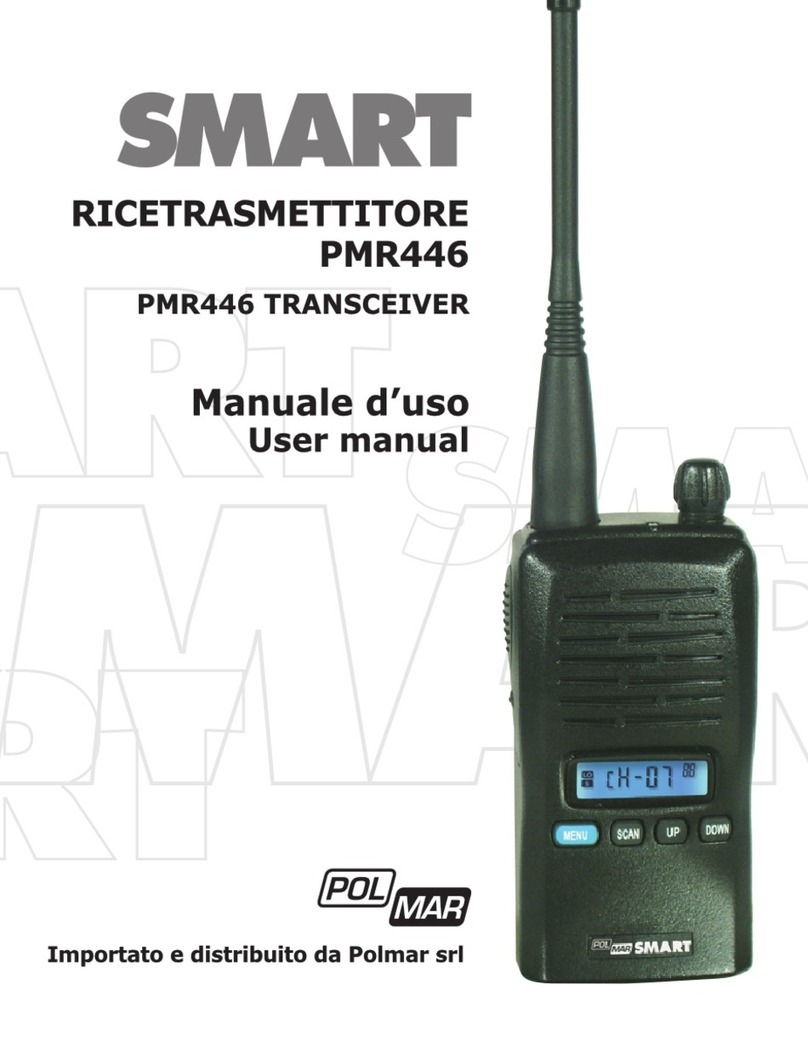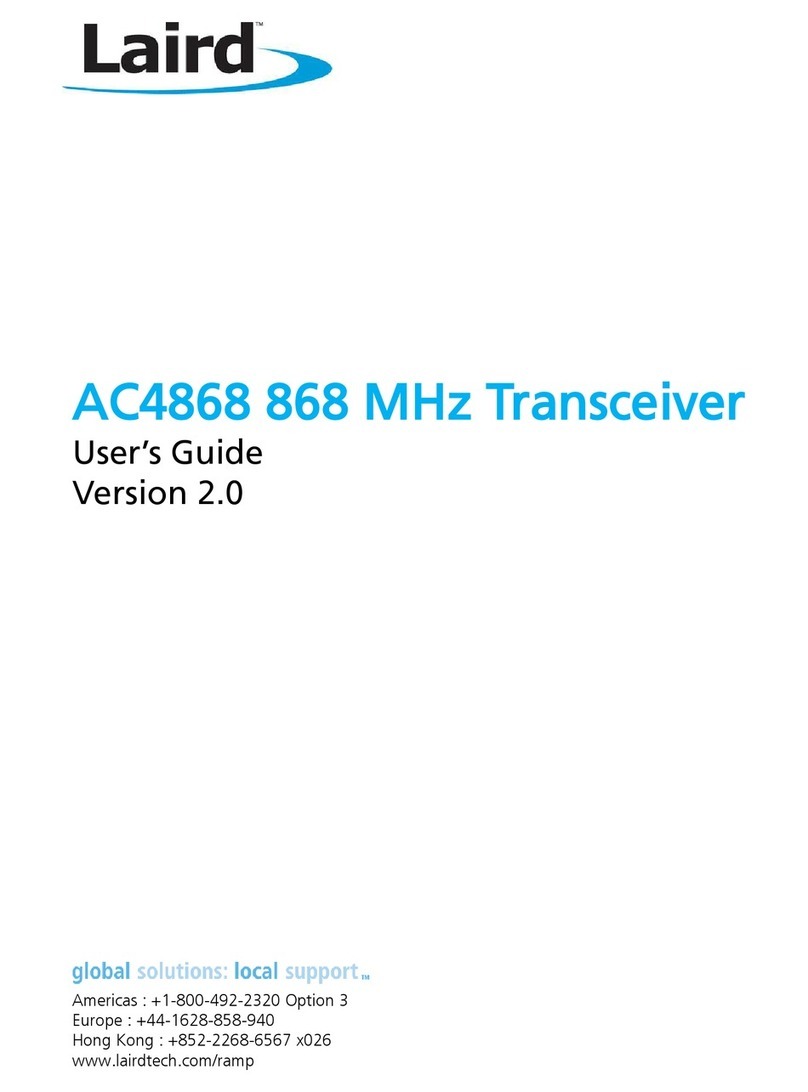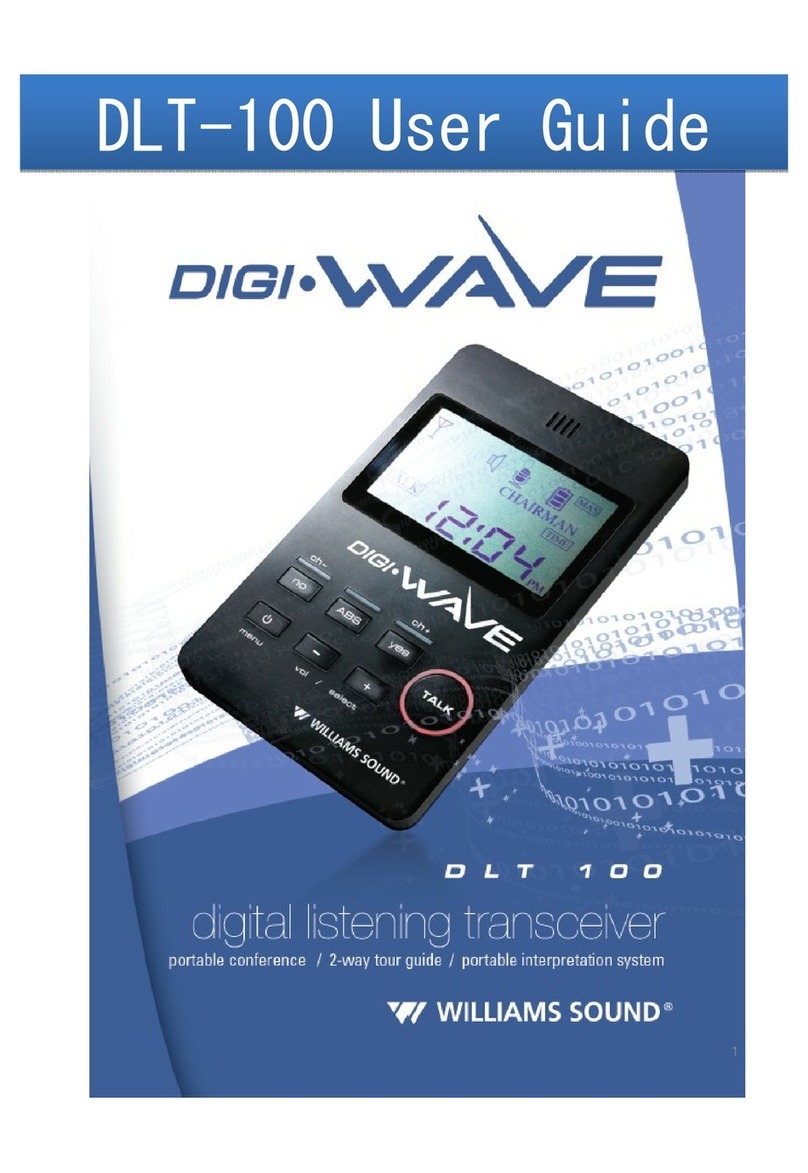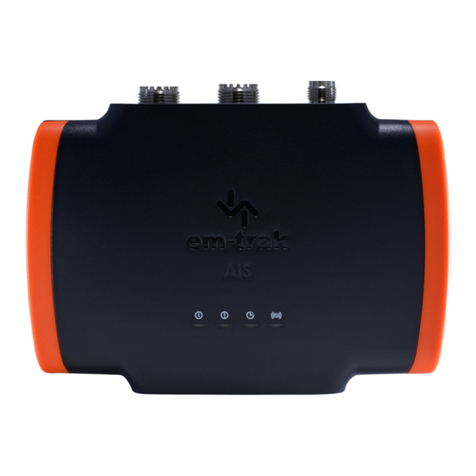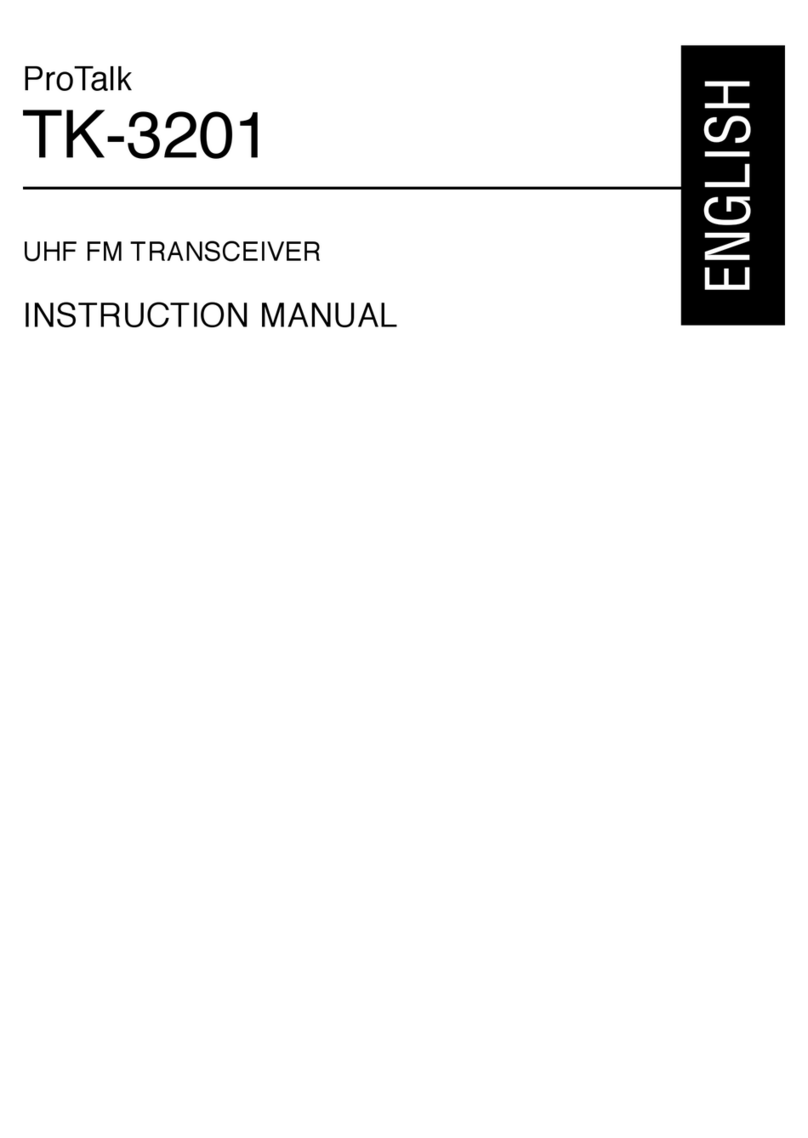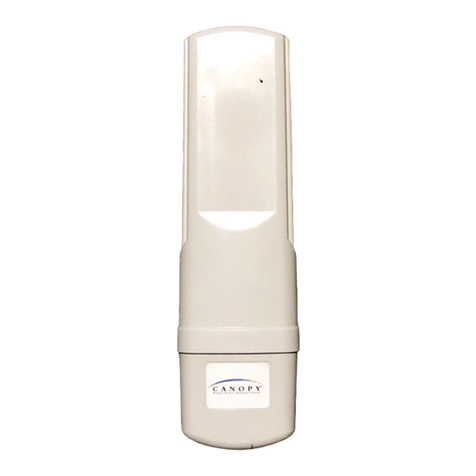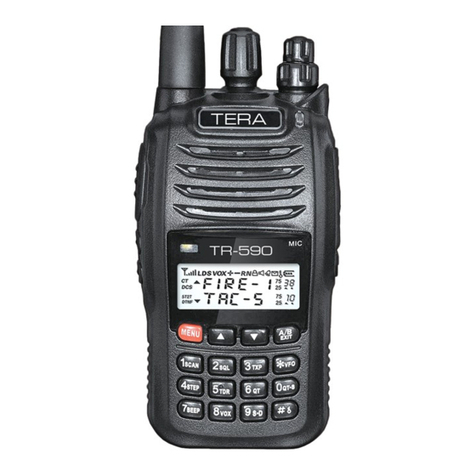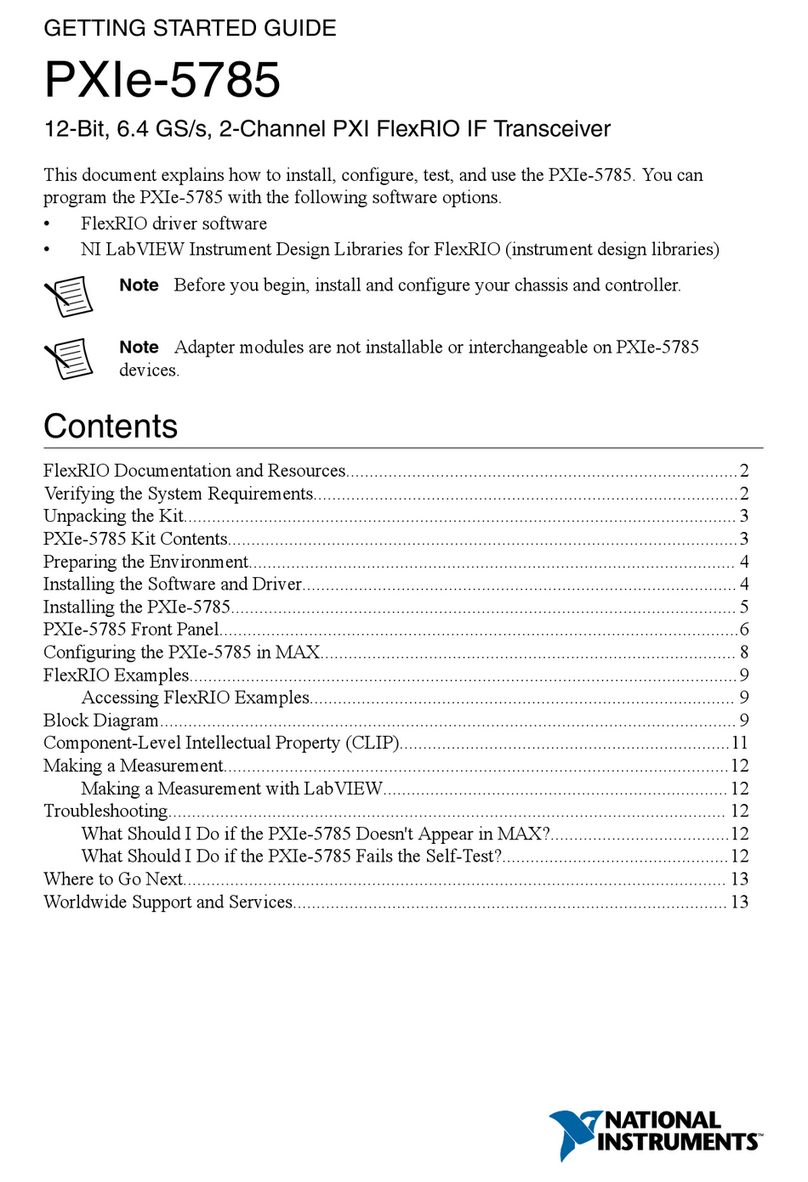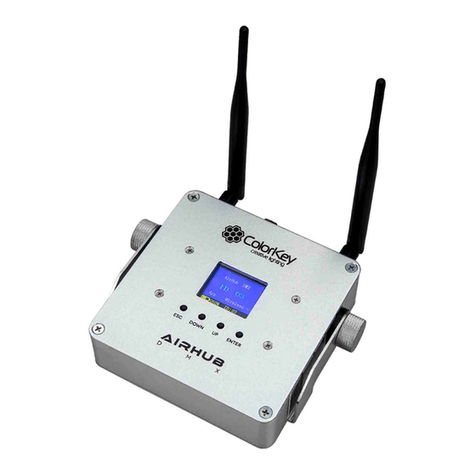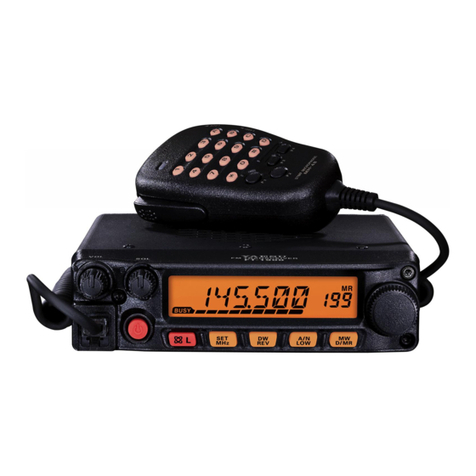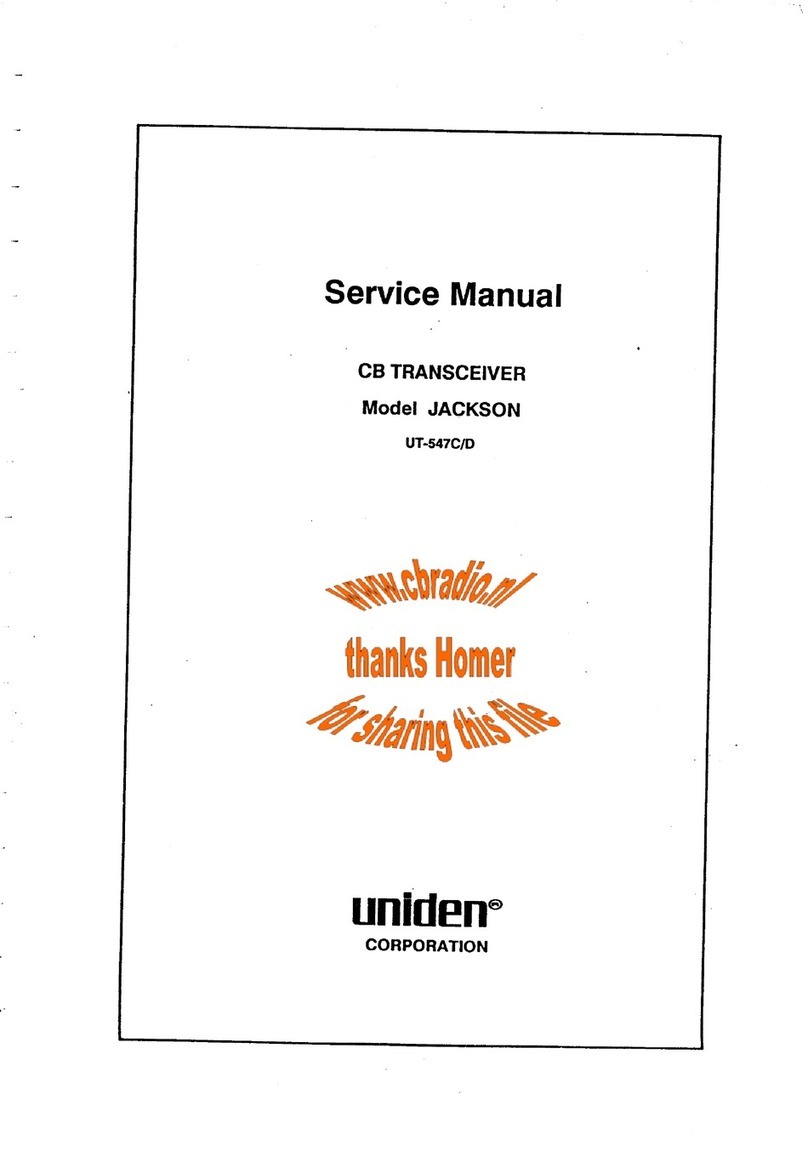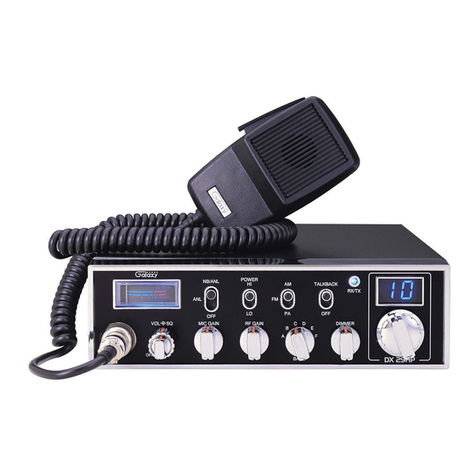Icom IC-F70DT User manual

INSTRUCTION MANUAL
This device complies with Part 15 of the FCC Rules. Operation is
subject to the condition that this device does not cause harmful
interference.
iF80DT/DS
UHF TRANSCEIVER
iF80T/S
The photo shows the IC-F70DT/T
or IC-F80DT/T.
iF70DT/DS
VHF TRANSCEIVER
iF70T/S

i
IMPORTANT
READ ALL INSTRUCTIONS carefully and com-
pletely before using the transceiver.
SAVE THIS INSTRUCTION MANUAL — This
instruction manual contains important operating instructions
for the IC-F70DT/F70DS/F70T/F70S VHF TRANSCEIVERS
and IC-F80DT/F80DS/F80T/F80S UHF TRANSCEIVERS.
EXPLICIT DEFINITIONS
WORD DEFINITION
RDANGER Personal death, serious injury or an explo-
sion may occur.
RWARNING Personal injury, fire hazard or electric
shock may occur.
CAUTION Equipment damage may occur.
NOTE
If disregarded, inconvenience only. No risk
of personal injury, fire or electric shock.
See the operating guide for details of MDC 1200 system
operation. Consult with your Icom dealer or system opera-
tor for details concerning your transceiver’s programming.
ABOUT APCO PROJECT 25
This device made under license under one or more of the follow-
ing US patents: #4,590,473, #4,636,791, #5,148,482, #5,185,796,
#5,271,017, #5,377,229.
The IMBE™ voice coding Technology embodied in this product is
protected by intellectual property rights including patent rights, copy-
rights and trade secrets of Digital Voice Systems, Inc. This voice cod-
ing Technology is licensed solely for use within this Communications
Equipment. The user of this Technology is explicitly prohibited from
attempting to decompile, reverse engineer, or disassemble the Object
Code, or in any other way convert the Object Code into a human-
readable form. U.S. Pat. Nos. #5,870,405, #5,826,222, #5,754,974,
#5,701,390, #5,715,365, #5,649,050, #5,630,011, #5,581,656,
#5,517,511, #5,491,772, #5,247,579, #5,226,084, #5,195,166.
ABOUT FM APPROVED
Versions of the IC-F70/F80 which display the “FM
APPROVED” symbol as at left on the serial number
seal, conform to intrinsically safe ratings of the
FMRC (Factory Mutual Research Corporation).
Intrinsically safe :
Class I, II, III, Division 1, Groups C, D, E, F, G
Nonincendive : Class I, Division 2, Groups A, B, C, D
Connected battery pack : BP-254FM
The repair and maintenance of an FM approved transceiver can only
be performed in an Factory Mutual approved repair facility. The FM
approval will be canceled if FM intrinsically safe radios are repaired
anywhere else except in an approved facility.

CAUTION! NEVER hold the transceiver so that the an-
tenna is very close to, or touching exposed parts of the body,
especially the face or eyes, while transmitting.The transceiver
will perform best if the microphone is 5 to 10 cm (2 to 4 in.)
away from the lips and the transceiver is vertical.
CAUTION! NEVER operate the transceiver with a
headset or other audio accessories at high volume levels.
CAUTION! NEVER short the terminals of the battery
pack.
CAUTION! NEVER
use non-Icom battery packs/char-
gers to prevent the loss of the transceiver’s good performance
and warranty.
DO NOT push PTT when not actually desiring to transmit.
DO NOT use or place the transceiver in direct sunlight or
in areas with temperatures below –30°C (–22°F) or above
+60°C (+140°F).
The basic operations, transmission and reception of the trans-
ceiver are guaranteed within the specified operating tempera-
ture range. However, the LCD display may not be operate
correctly, or show an indication in the case of long hours of
operation, or after being placed in extremely cold areas.
DO NOT modify the transceiver for any reason.
Optional unit installation should be done at authorized Icom
service center only.
BE CAREFUL! The IC-F70/F80 series transceivers
employ waterproof construction, which corresponds to IPX7
of the international standard IEC 60529 (2001), 1 m depth
for 30 minutes. However, once the transceiver has been
dropped, waterproofing cannot be guaranteed due to the fact
that the transceiver may be cracked, or the waterproof seal
damaged, etc.
Approved Icom optional equipment is designed for optimal
performance when used with an Icom transceiver. Icom is not
responsible for the destruction or damage to an Icom trans-
ceiver in the event the Icom transceiver is used with equip-
ment that is not manufactured or approved by Icom.
For U.S.A. only
CAUTION: Changes or modifications to this transceiver, not
expressly approved by Icom Inc., could void your authority to
operate this transceiver under FCC regulations.
PRECAUTIONS
ii
Icom, Icom Inc. and the Icom logo are registered trademarks of Icom Incor-
porated (Japan) in Japan, the United states, the United Kingdom, Germany,
France, Spain, Russia and/or other countries.
All other products or brands are registered trademarks or trademarks of their
respective holders.

iii
TABLE OF CONTENTS
IMPORTANT.......................................................................... i
EXPLICIT DEFINITIONS....................................................... i
ABOUT APCO PROJECT 25 ................................................ i
ABOUT FM APPROVED ....................................................... i
PRECAUTIONS.................................................................... ii
TABLE OF CONTENTS....................................................... iii
1 ACCESSORIES ...........................................................1–3
■ Supplied accessories ...................................................1
■ Accessory attachments ................................................ 1
2 PANEL DESCRIPTION..............................................4–11
■Front panel ...................................................................4
■ Function display ...........................................................6
■ Programmable function keys........................................7
3 BASIC OPERATION................................................12–18
■ Turning power ON ......................................................12
■ Channel selection.......................................................12
■ Call procedure............................................................13
■ Receiving and transmitting.........................................13
■ User set mode............................................................17
■ Scrambler function .....................................................18
4 BATTERY CHARGING ............................................19–22
■ Caution.......................................................................19
■ Optional battery chargers...........................................21
5 BATTERY CASE............................................................23
■ Optional battery case (BP-237)..................................23
6 SWIVEL BELT CLIP ................................................24–25
■ MB-93 contents ..........................................................24
■ To attach.....................................................................24
■ To detach....................................................................25
7 SPEAKER-MICROPHONE............................................26
■ Optional HM-138 description......................................26
■ Attachment .................................................................26
8 OPTIONS.................................................................27–30
9 SAFETY TRAINING INFORMATION.......................31–32
10
FCC INFORMATION......................................................33

1
ACCESSORIES
1
■Supplied accessories
The following accessories are supplied: Qty.
qFlexible antenna.............................................................. 1
wBattery pack.................................................................... 1
eBelt clip ........................................................................... 1
rConnector cover (with screw).................................... 1 set
q w e
r
■Accessory attachments
DFlexible antenna
Connect the supplied flexible an-
tenna to the antenna connector.
CAUTION:
•
NEVER HOLD the antenna
when carrying the transceiver.
•Transmitting without an antenna
may damage the transceiver.
1
1
2
3
4
5
6
7
8
9
10
11
12
13
14
15
16

2
1ACCESSORIES
DBattery pack
To attach the battery pack:
Slide the battery pack in the direction of the arrow (q), then
lock it with the battery release button.
• Slide the battery pack until the battery release button makes a ‘click’
sound.
To release the battery pack:
Slide the battery release button in the direction of the arrow
(w) as shown below. The battery pack is then released.
NEVER release or attach the battery pack when the trans-
ceiver is wet or soiled. This may result water or dust getting
into the transceiver/battery pack and may result in the
transceiver being damaged.
q
w
Battery release button
DBelt clip
To attach the belt clip:
qRelease the battery pack if it is attached.
wSlide the belt clip in the direction of the arrow until the belt
clip is locked and makes a ‘click’ sound.
To detach the belt clip:
qRelease the battery pack if it is attached.
wPinch the clip (q), and slide the belt clip in the direction of
the arrow (w).
q
w

1
ACCESSORIES
DConnector cover
Attach the connector cover when the optional speaker-micro-
phone is not used.
To attach the connector
cover:
q
Insert the connector cover
into the multi-connector.
wTighten the screw.
To detach the connector
cover:
eUnscrew the screw using
a phillips screwdriver.
rDetach the connector
cover for the speaker-mi-
crophone connection.
q
we
r
Multi-
connector
Connector
cover
3
1
2
3
4
5
6
7
8
9
10
11
12
13
14
15
16

4
2PANEL DESCRIPTION
■Front panel
q
!2
!1
!0
w
e
r
t
Speaker
Microphone
o
y
u
i
qVOLUME CONTROL [VOL]
Rotate to turn the power ON/OFF and adjusts the audio
level.
wROTARY SELECTOR
Rotate to select the pre-programmed memory channels or
the operating zone.
(Depending on the pre-setting)
eANTENNA CONNECTOR
Connects the supplied antenna.
rEMERGENCY SWITCH
Push and hold for a specified period to transmit an emer-
gency call.
• Desired function can be programmed by your dealer. (p. 7)
tBUSY/TRANSMIT INDICATOR
➥
Lights green while receiving a signal, or when the
squelch is open.
➥Lights red while transmitting.
yMULTI-CONNECTOR
Connect the optional speaker-microphone.
Connector cover
NOTE: Attach the connec-
tor cover when the optional
speaker-microphone is not
used. (See p. 3 for details)
uFUNCTION DISPLAY (p. 6)
Displays a variety of information, such as an operating
channel number/name, 5-tone code, DTMF numbers and
audible condition, etc.
iDEALER-PROGRAMMABLE KEYS
Desired functions can be programmed independently by
your dealer. (p. 7)

o10-KEYPAD (IC-F70DT/F70T or IC-F80DT/F80T only)
The keypad allows you to enter digits to:
• Select memory channels, tone channels and DTMF codes (dur-
ing transmission).
• Start up with a password.
• Set the Individual ID code for digital operation.
• Set TX codes.
!0 MONITOR SWITCH
➥
Mute and release the CTCSS (DTCS) or 2-tone squelch
mute. Open any squelch/deactivate any mute while push-
ing and holding this key. (LMR operation only)
➥Activates one of (or two of) the following functions on
each channel independently. (PMR operation only)
• Push and hold the key to unmute the channel (audio is emit-
ted; ‘audible’ condition).
• Push the key to toggle the mute and unmute conditions (tog-
gles ‘audible’ and ‘inaudible’).
• Push the key to mute the channel (sets to ‘inaudible’ only).
• Push the key to unmute the channel (sets to ‘audible’ only).
• Push the key after communication is finished to send a ‘reset
code.’
NOTE: The unmute condition (‘audible’ conditions)
may automatically return to the mute condition (‘in-
audible’ condition) after a specified period.
• Desired function can be programmed by your dealer. (p. 7)
!1 PTT SWITCH [PTT]
Push and hold to transmit; release to receive.
!2 UP/DOWN SWITCHES
➥ Push to select an operating channel.
➥ Push to select a TX code channel after pushing
[TX CODE CH SELECT].
➥ Push to select a DTMF channel after pushing [DTMF].
➥ Push to select a scan group after pushing and holding
[SCAN].
• Desired functions can be programmed independently by your
dealer. (p. 7)
5
2
PANEL DESCRIPTION
1
2
3
4
5
6
7
8
9
10
11
12
13
14
15
16

6
2PANEL DESCRIPTION
■Function display
q t iuyrew
o
!0
qSIGNAL STRENGTH INDICATOR
Indicates relative signal strength level.
wLOW POWER INDICATOR
Appears when low output power is selected.
eAUDIBLE INDICATOR
➥ Appears when the channel is in the ‘audible’ (unmute)
condition.
➥ Appears when the specified 2/5-tone/MDC 1200 code is
received.
r COMPANDER INDICATOR
Appears when the compander function is activated.
t SCRAMBLER INDICATOR
Appears when the voice scrambler function is activated.
y BELL INDICATOR
Appears/blinks when the specific 2/5-tone/MDC 1200 code
is received, according to the pre-programming.
u CALL CODE MEMORY INDICATOR
Appears when the call code memory is selected.
i BATTERY INDICATOR
Appears or blinks when the battery power decreases to a
specified level.
o ALPHANUMERIC DISPLAY
➥ Displays an operating channel number, channel name,
Set mode contents, DTMF code, etc.
➥The indication mode can be selected from 1 line or 2
lines. Ask your dealer for details.
• In this instruction manual, the LCD illustration is described
using the 2 lines indication mode.
!0 KEY INDICATOR
Indicate the programmed function of the front panel keys
([P0], [P1], [P2] and [P3]).

■Programmable function keys
The following functions can be assigned to [EMERGENCY],
[UP], [DOWN], [MONITOR], [P0], [P1], [P2] and [P3] pro-
grammable function keys.
Consult your Icom dealer or system operator for details con-
cerning your transceivers programming.
If the programmable function names are bracketed in the fol-
lowing explanations, the specific key is used to activate the
function depends on the programming.
CH UP AND DOWN KEYS “UP” “DOWN”
➥Push to select an operating channel.
➥Push to select a transmit code channel after pushing [TX
Code CH Select].
➥Push to select a DTMF channel after pushing [DTMF Au-
todial].
➥Push to select a scan group after pushing and holding
[Scan A Start/Stop]/[Scan B Start/Stop].
➥Push to select an Individual ID code or Talkgroup ID code
after pushing [Individual] or [Talkgroup].
ZONE KEY “ZONE”
Push this key, then select the desired zone using [CH Up]/
[CH Down].
What is “zone”?— The desired channels are assigned
into a zone according to the intended use for grouping. For
example, ‘Staff A’ and ‘Staff B’ are assigned into a “Busi-
ness” zone, and ‘John’ and ‘Cindy’ are assigned into a “Pri-
vate” zone.
SCAN A START/STOP KEY “SCNA”
➥This key’s operation depends on the Power ON Scan setting.
When the power ON scan function is turned OFF;
Push to start and cancel scanning operation. In case of
transmission during scan, cancels scanning.
When the power ON scan function is turned ON;
Push to pause scanning. Scanning resumes after a specified
time period has passed. In case of transmission during scan,
pauses scanning. Scanning resumes after a specified time
period has passed after the transmission is finished.
➥Push and hold this key for 1 sec. to indicate the scan group,
then select the desired group using [CH Up]/[CH Down].
SCAN B START/STOP KEY “SCNB”
➥Push to start and cancel scanning operation. In case of
transmission during scan, pauses scanning. Scanning re-
sumes after a specified time period has passed after the
transmission is finished.
➥Push and hold this key for 1 sec. to indicate the scan
group, then select the desired group using [CH Up]/
[CH Down].
7
2
PANEL DESCRIPTION
1
2
3
4
5
6
7
8
9
10
11
12
13
14
15
16

8
2PANEL DESCRIPTION
SCAN ADD/DEL (TAG) KEY “SCAD”
Push to add or delete the selected channel to/from the scan
group.
PRIO A/B KEYS “PRA”/“PRAR”/“PRB”/“PRBR”
➥Push to select Priority A or Priority B channel.
➥Push and hold [Prio A (Rewrite)] or [Prio B (Rewrite)] to
rewrite the Priority A or Priority B channel to the selected
channel.
MR-CH 1/2/3/4 KEYS “CH1”/“CH2”/“CH3”/“CH4”
Push to select an operating channel directly.
MONI (AUDI) KEY “MON”
➥Mute and release the CTCSS (DTCS) or 2-tone squelch
mute. Open any squelch/deactivate any mute while pushing
this key. (LMR operation only)
➥
Activates one of (or two of) the following functions on each
channel independently: (PMR operation only)
• Push and hold to un-mute the channel (audio is emitted;‘Audible’
condition).
• Push to mute the channel (sets to ‘Inaudible’ only).
• Push to un-mute the channel (sets to ‘Audible’ only).
• Push after the communication is finished to send a ‘reset code’.
NOTE: The un-mute condition (‘Audible’ condition) may au-
tomatically return to the mute condition (‘Inaudible
’
condi-
tion) after a specified period depending on programming.
LIGHT KEY “LIGT”
Push to turn the transceiver’s backlight ON temporarily only
when the backlight function is turned OFF in user set mode.
LOCK KEY “LOCK”
➥Push and hold for 1 sec. to electronically lock all program-
mable keys except the following:
[Call] (incl. Call A and Call B), [Moni(Audi)] and [Emergency].
➥
Push and hold for 1 sec. again to turn the lock function
OFF.
HIGH/LOW KEY “H/L”
Push to select the transmit output power temporarily or per-
manently, depending on the pre-setting.
• Ask your dealer for the output power level for each selection.
C.TONE CH ENT KEY “TSEL”
Push to select the continuous tone channel using [CH Up]/
[CH Down] to change the tone frequency/code setting. The
selected channel remains set as the continuous tone channel
until another channel is designated as such.
TALK AROUND KEY “TA”
Push to turn the talk around function ON and OFF.
• The talk around function equalizes the transmit frequency to the
receive frequency for transceiver-to-transceiver communication.
WIDE/NARROW KEY “W/N”
Push to toggle the IF bandwidth between wide and narrow.
• The wide passband width can be selected from 25.0 or 20.0 kHz
using the CS-F70/F1700 cloning software. (PMR operation only)
Ask your Dealer for details.
RE-DIAL KEY “DTMR”
Push to transmit the last-transmitted DTMF code.

DTMF AUTODIAL KEY “DTMA”
➥
Push to enter the DTMF channel selection mode.Then select
the desired DTMF channel using [CH Up]/[CH Down].
➥After selecting the desired DTMF channel, push this key to
transmit the DTMF code.
CALL KEYS “CALL”/“CALA”/“CALB”
Push to transmit a 2/5-tone ID code.
• Call transmission is necessary before calling another station depend-
ing on your signalling system.
• [Call A] and/or [Call B] may be available when your system employs
selective ‘Individual/Group’ calls. Ask your dealer which call is
assigned to each key.
EMERGENCY KEYS “EMR”
Push and hold for a specified period to transmit an emergency
call.
• If you want to cancel the emergency call, push (or push and hold)
the key again before transmitting the call.
• The emergency call is transmitted one time only or repeatedly until
receiving a control code depending on the pre-setting.
SURVEILLANCE KEY “SURV”
Push to turn the surveillance function ON or OFF.
When this function is turned ON, the beep is not emitted and
the LCD backlight does not light when a signal is received or
a key is pushed, etc.
TX CODE ENTER KEY “TXCE” (PMR operation only)
Push to enter the ID code edit mode directly, for 5-tone. Then
set the desired digit using [CH Up]/[CH Down] or 10-keypad*.
(p. 15)
*IC-F70DT/T or IC-F80DT/T only
TX CODE CHANNEL SELECT KEY “TXC”
➥Push to enter the ID code channel selection mode directly.
Then set the desired channel using [CH Up]/[CH Down].
(p. 14)
➥During ID code channel selection mode, push for 1 sec. to
enter the ID code edit mode for 5-tone.Then set the desired
digit using [CH Up]/[CH Down] or 10-keypad*. (p. 15)
*IC-F70DT/T or IC-F80DT/T only
TX CODE CHANNEL UP/DOWN KEYS “TXCU”/“TXCD”
Push to select a TX code channel directly.
ID-MR SELECT KEY “IDMS” (PMR operation only)
➥Recalls detected ID codes.
• Push this key, then select the ID code using [CH Up]/[CH
Down].
• Up to 5 ID’s are memorized.
➥Push and hold to erase the selected ID’s.
SCRAMBLER FUNCTION “SCR”
Push to toggle the voice scrambler function ON and OFF.
9
2
PANEL DESCRIPTION
1
2
3
4
5
6
7
8
9
10
11
12
13
14
15
16

10
2PANEL DESCRIPTION
COMPANDER KEY “COMP”
Push to toggle the compander function ON and OFF.
The compander function reduces noise components from the
transmitted audio to provide clear communication.
USER SET MODE KEY “SET”
➥Push and hold to enter user set mode.
• During user set mode, push this key to select an item, and change
the value or condition using push [CH Up]/[CH Down].
➥Push and hold this key again to exit user set mode.
User set mode is also available via the ‘Power ON function.’
Refer to p. 17 also.
OPT OUT KEYS “OP1”/“OP2”/“OP3”
Push to control the output signal level of the optional ports in
the optional unit connector.
OPT MOMENTARY KEYS “01M”/“02M”/“03M”
Push and hold to control the output signal level of the optional
ports in the optional unit connector.
TONE/NAC CH SELECT KEY “TSEL”
(LMR (P25 Conventional) operation only)
➥While in the analog mode operation, push to select the
continuous tone channel using [CH Up] or [CH Down] to
change the tone frequency/code setting.
➥While in the digital mode operation, push to select the NAC
channel using [CH Up] or [CH Down] to change the NAC
code setting.
➥While in the mixed (digital and analog) mode operation,
push to select the continuous tone channel using [CH Up]
or [CH Down] to change the tone frequency/code setting.
Then push this key to enter the setting. After that, the NAC
channel selection screen appears. Select the NAC channel
using [CH Up] or [CH Down] to change the NAC code set-
ting. Then push this key to enter the setting.

SCRAMBLER/ENCRYPTION KEY “S/D”
(LMR (P25 Conventional) operation only)
➥While in the analog mode operation, push to toggle the
voice scrambler function ON and OFF.
➥While in the digital mode operation, push to toggle the en-
cryption transmission function ON and OFF.
➥While in the mixed (digital and analog) mode operation,
push to toggle the voice scrambler and encryption trans-
mission functions ON and OFF, separately or simultane-
ously as below.
Voice scrambler function ON
Voice scrambler and Encryption transmittion
functions ON
Voice scrambler and Encryption transmittion
functions OFF
Encryption transmittion function ON
PUSH
PUSH
PUSH
PUSH
(appears)
(appears)
(appears)
(disappears)
DFor Digital mode operation only
INDIVIDUAL KEY “INDV”
Push to enter the individual ID code selection mode directly.
Then select the desired individual ID code using [CH Up]/
[CH Down]. (p. 16)
TALKGROUP KEY “TGID”
Push to enter the talkgroup ID code selection mode directly.
Then select the desired talkgroup ID code using [CH Up]/
[CH Down]. (p. 16)
ZEROIZE KEY “ZERO”
Push and hold to zeroize the encryption key data, programmed
by the FS-F70/F1700 flash loader.
ENCRYPTION KEY “DENC”
Push to toggle the encryption transmission function ON or
OFF.
When this function is turned ON, “ ” appears on the function
display.
11
2
PANEL DESCRIPTION
1
2
3
4
5
6
7
8
9
10
11
12
13
14
15
16

12
3BASIC OPERATION
■Turning power ON
Prior to using the transceiver for the first time, the battery
pack must be fully charged for optimum life and operation.
(p. 19)
qRotate [VOL] to turn the power ON.
wIf the transceiver is programmed for a start up password,
input the digit codes as directed by your dealer.
• 10-keypad* can be used for password input.
*IC-F70DT/T or IC-F80DT/T only
• The keys as below can be used for password input:
The transceiver detects numbers in the same block as identical.
Therefore “01234” and “56789” are the same.
KEY
NUMBER 0
5
4
9
3
8
2
7
1
6
[MONI]
[P0]/[P1]/
[P2]/[P3]
MONI
[VOL]
eWhen the “PASSWORD” indication does not clear after in-
putting 6 digits, the input code number may be incorrect.
Turn the power off and start over in this case.
■Channel selection
Several types of channel selections are available. Methods
may differ according to your system set up.
NON-ZONE TYPE:
Push [CH Up] or [CH Down], or rotate [ROTARY SELECTOR]*
to select the desired operating channel, in sequence; or, push
one of [MR-CH 1] to [MR-CH 4] keys to select a channel di-
rectly.
• Up to 16 pre-programmed channels can be selected via [ROTARY
SELECTOR].
ZONE TYPE:
Push [Zone] then push [CH Up] or [CH Down] or rotate [RO-
TARY SELECTOR]* to select the desired zone.
*Depending on the pre-setting.
AUTOMATIC SCAN TYPE:
Channel setting is not necessary for this type. When turn-
ing power ON, the transceiver automatically starts scanning.
Scanning stops when receiving a call.

■Call procedure
When your system employs tone signaling (excluding CTCSS
and DTCS), the call procedure may be necessary prior to voice
transmission. The tone signalling employed may be a selective
calling system which allows you to call specific station(s) only
and prevent unwanted stations from contacting you.
qSelect the desired TX code channel, 2/5-tone code, Indi-
vidual ID code* or Talkgroup ID code* according to your
System Operator’s instructions.
• This may not be necessary depending on programming.
• Refer to pgs. 14–16 for selection.
*Digital mode operation only.
w
Push the call key (assigned to one of the dealer program-
mable keys; except for the Digital mode operation) or [PTT].
eAfter transmitting, the remainder of your communication
can be carried out in the normal fashion.
Selective calling Non-selective calling
■Receiving and transmitting
Receiving:
qRotate [VOL] to turn the power ON.
wPush [CH Up] or [CH Down], or rotate [ROTARY SELEC-
TOR]* to select a channel in sequence.
*Depending on the pre-setting.
eWhen receiving a call, adjust the audio output level to a
comfortable listening level.
Transmitting:
Wait for the channel to become clear to avoid interference.
qPush [CALL] when initiating a call from your side.
• Coded audio may be heard from the transceiver, then “ ” ap-
pears.
• This operation may not be necessary depending on your signal-
ing system. Ask your dealer for details.
wWhile pushing and holding [PTT], speak into the micro-
phone at your normal voice level.
eRelease [PTT] to return to receive.
IMPORTANT: To maximize the readability of your signal;
1. Pause briefly after pushing [PTT].
2. Hold the microphone 5 to 10 cm (2 to 4 inches) from
your mouth, then speak into the microphone at a normal
voice level.
13
3
BASIC OPERATION
1
2
3
4
5
6
7
8
9
10
11
12
13
14
15
16

14
3BASIC OPERATION
DTransmitting notes
• Transmit inhibit function
The transceiver has several inhibit functions which restrict
transmission under the following conditions:
- The channel is in mute condition (‘Inaudible’ condition;
“”does not appear.)
- The channel is busy.
- Un-matched (or matched) CTCSS is received.
(Depending on the pre-setting.)
- Un-matched (or matched) NAC is received.*
(Depending on the pre-setting.)
- The selected channel is a ‘receive only’ channel.
*Digital mode operation only.
• Time-out timer
After continuous transmission for the pre-programmed time
period, the time-out timer is activated, causing the transceiver
to stop transmitting.
• Penalty timer
Once the time-out timer is activated, transmission is further
inhibited for a period determined by the penalty timer.
DTX code channel selection
If the transceiver has [TX Code CH Select] assigned to it,
the indication can be toggled between the operating channel
number (or name) and TX code channel number (or name).
When the TX code channel number (or name) is displayed,
[CH Up] or [CH Down] selects the TX code channel.
USING [TX CODE CH SELECT] KEY:
qPush [TX Code CH Select]—a TX code channel number
(or name) appears.
wPush [CH Up] or [CH Down] to select the desired TX code
channel.
ePush [Call] to transmit the selected TX code.
USING [TX CODE CH UP]/[TX CODE CH DOWN] KEY:
If the transceiver has a [TX Code CH Up] or [TX Code CH
Down] key assignment, the programmed TX code channel
can be selected directly when pushed.

DTX code number edit (PMR operation only)
If the transceiver has [TX Code CH Select] or [TX Code
Enter] assigned to it, TX code contents can be edited within
the allowable digits.
USING [TX CODE CH SELECT] KEY:
qPush [TX Code CH Select] to enter the TX code channel
selection mode.
• Select the desired channel before entering the TX code channel
selection mode if necessary.
wPush and hold [TX Code CH Select] for 1 sec. to enter the
TX code edit mode.
ePush [TX Code CH Select] to select the desired digit to
be edited.
• The digit to be edited blinks.
rPush [CH Up], [CH Down] or 10-keypad* to set the desired
digit.
tPush [TX Code CH Select] to set the digit. The digit to the
right will blink automatically.
• When the 10-keypad* is used for setting, the digit to the right will
blink automatically without pushing [TX Code CH Select].
yRepeat rand tto input all allowable digits.
uPush [Call] to transmit.
*IC-F70DT/T or IC-F80DT/T only
USING [TX CODE ENTER] KEY:
qSelect the desired TX code channel via [TX Code CH
Select]+[CH Up] or [CH Down], [TX Code CH Up] or [TX
Code CH Down].
wPush [TX Code Enter] to enter the TX code edit mode.
ePush [TX Code Enter] to select the desired digit to be ed-
ited.
• The digit to be edited blinks.
rPush [CH Up], [CH Down] or 10-keypad* to set the desired
digit.
tPush [TX Code Enter] to set the digit. The digit to the right
will blink automatically.
• When the 10-keypad* is used for setting, the digit to the right will
blink automatically without pushing [TX Code CH Enter].
yRepeat rand tto input all allowable digits.
uPush [Call] to transmit.
*IC-F70DT/T or IC-F80DT/T only
15
3
BASIC OPERATION
1
2
3
4
5
6
7
8
9
10
11
12
13
14
15
16

16
3BASIC OPERATION
DIndividual ID code selection
(Digital mode operation only)
If the transceiver has [Individual] assigned to it, the indication
can be toggled between the operating channel number (or
name) and Individual ID code (or name). When the Individual
ID code (or name) is displayed, [CH Up] or [CH Down] se-
lects the desired Individual ID code.
qPush [Individual]— an Individual ID code (or name) ap-
pears.
wPush [CH Up] or [CH Down] to select the desired Indi-
vidual ID code.
ePush [PTT] to transmit the selected Individual ID code.
rPush [Individual]— cancels the selected Individual ID code
(return to the pre-set Talkgroup ID code in the channel.)
DTalkgroup ID code selection
(Digital mode operation only)
If the transceiver has [Talkgroup] assigned to it, the indication
can be toggled between the operating channel number (or
name) and Talkgroup ID code (or name). When the Talkgroup
ID code (or name) is displayed, [CH Up] or [CH Down] se-
lects the desired Talkgroup ID code.
qPush [Talkgroup]— a Talkgroup ID code (or name) ap-
pears.
wPush [CH Up] or [CH Down] to select the desired Talk-
group ID code.
ePush [PTT] to transmit the selected Talkgroup ID code.
rChange the channel— cancels the selected Talkgroup ID
code (return to the pre-set Talkgroup ID code in the chan-
nel.)
DDTMF transmission
If the transceiver has [DTMF Autodial] assigned to it, the
automatic DTMF transmission function is available. Up to 8
DTMF channels are available.
TO SELECT A TX CODE:
qPush [DTMF Autodial]— a DTMF channel appears.
wPush [CH Up] or [CH Down] to select the desired DTMF
channel.
ePush [DTMF Autodial] to transmit the DTMF code in the
selected DTMF channel.
Other manuals for IC-F70DT
1
This manual suits for next models
7
Table of contents
Other Icom Transceiver manuals
